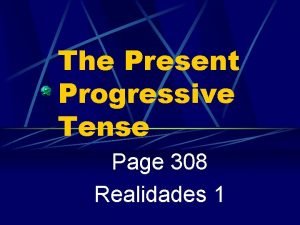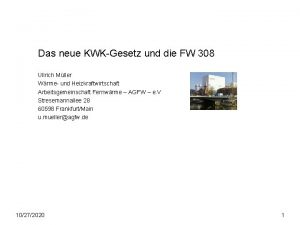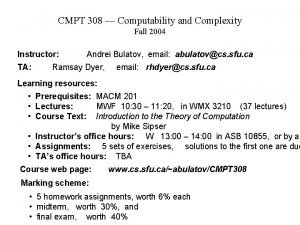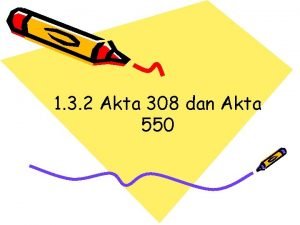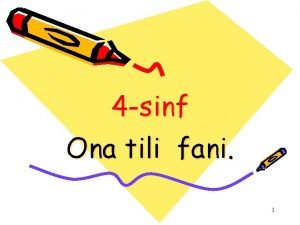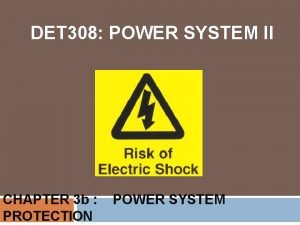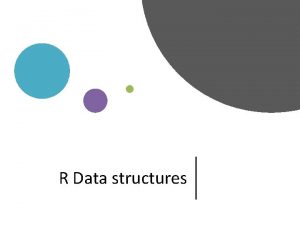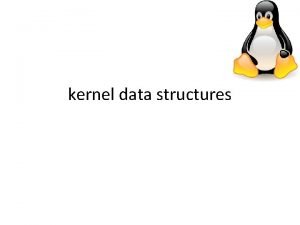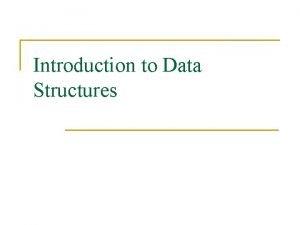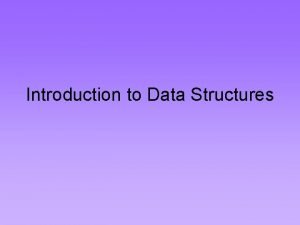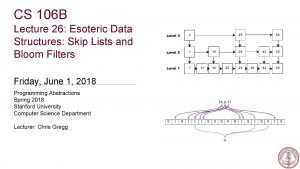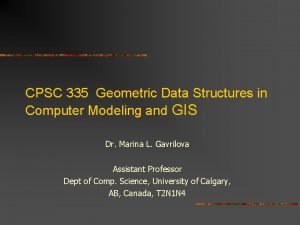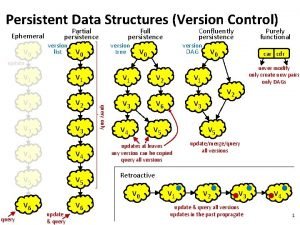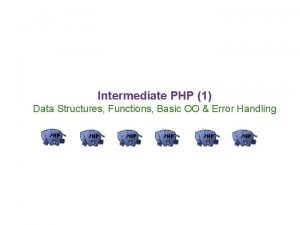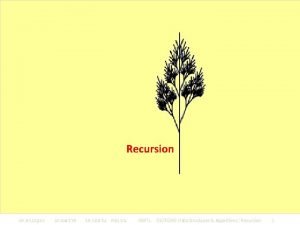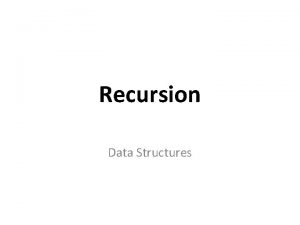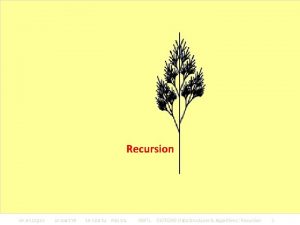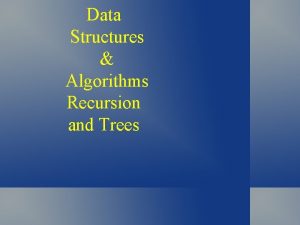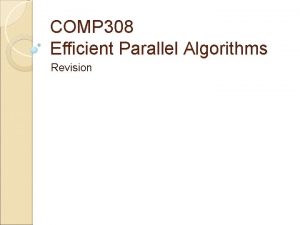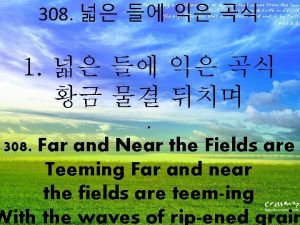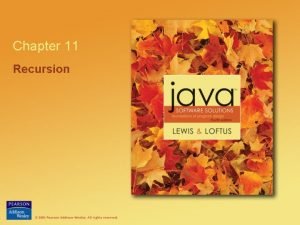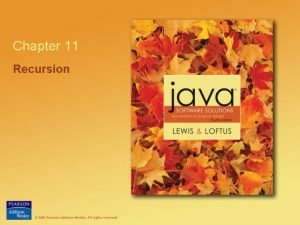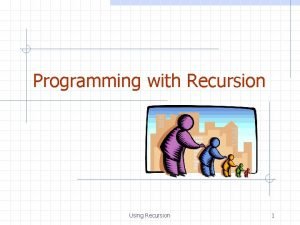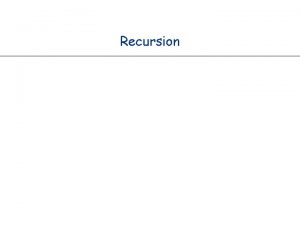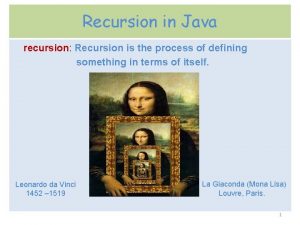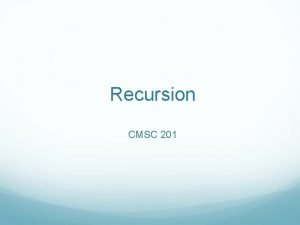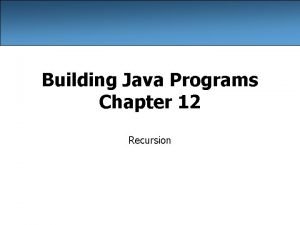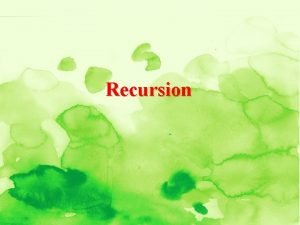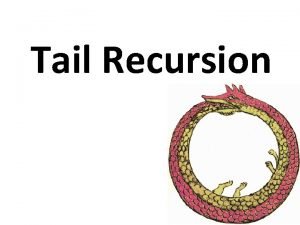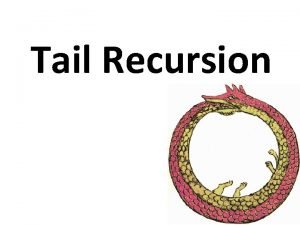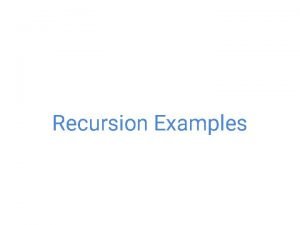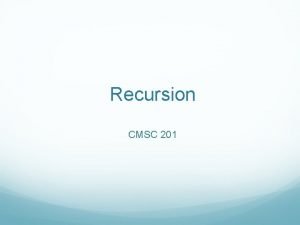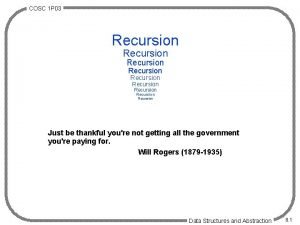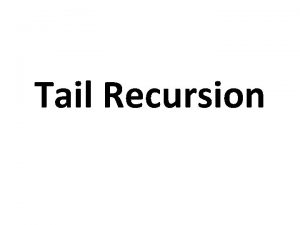Recursion CS 308 Data Structures What is recursion















![Recursive binary search (cont’d) template<class Item. Type> bool Binary. Search(Item. Type info[], Item. Type& Recursive binary search (cont’d) template<class Item. Type> bool Binary. Search(Item. Type info[], Item. Type&](https://slidetodoc.com/presentation_image_h/813207a96740a17ac6eafdf6acd2368e/image-16.jpg)
















- Slides: 32

Recursion CS 308 – Data Structures

What is recursion? • Sometimes, the best way to solve a problem • is by solving a smaller version of the exact smaller version same problem first Recursion is a technique that solves a problem by solving a smaller problem of the smaller problem same type

When you turn this into a program, you end up with functions that call themselves (recursive functions) int f(int x) { int y; if(x==0) return 1; else { y = 2 * f(x-1); return y+1; } }

Problems defined recursively • There are many problems whose solution can be defined recursively Example: n factorial n!= 1 if n = 0 (n-1)!*n if n > 0 1 if n = 0 (closed form solution) if n > 0 1*2*3*…*(n-1)*n (recursive solution)

Coding the factorial function • Recursive implementation int Factorial(int n) { if (n==0) // base case return 1; else return n * Factorial(n-1); }


Coding the factorial function (cont. ) • Iterative implementation int Factorial(int n) { int fact = 1; for(int count = 2; count <= n; count++) fact = fact * count; return fact; }

Another example: n choose k (combinations) • Given n things, how many different sets of size k can be chosen? n n-1 = + , 1 < k < n (recursive solution) k k k-1 n n! = k k!(n-k)! , 1 < k < n (closed-form solution) with base cases: n n = n (k = 1), = 1 (k = n) 1 n

n choose k (combinations) int Combinations(int n, int k) { if(k == 1) // base case 1 return n; else if (n == k) // base case 2 return 1; else return(Combinations(n-1, k) + Combinations(n-1, k-1)); }


Recursion vs. iteration • Iteration can be used in place of recursion – An iterative algorithm uses a looping construct – A recursive algorithm uses a branching structure • Recursive solutions are often less efficient, in • terms of both time and space, than iterative solutions Recursion can simplify the solution of a problem, often resulting in shorter, more easily understood source code

How do I write a recursive function? • Determine the size factor • Determine the base case(s) (the one for which you know the answer) • Determine the general case(s) (the one where the problem is expressed as a smaller version of itself) • Verify the algorithm (use the "Three-Question-Method")

Three-Question Verification Method 1. The Base-Case Question: Is there a nonrecursive way out of the function, and does the routine work correctly for this "base" case? 2. The Smaller-Caller Question: Does each recursive call to the function involve a smaller case of the original problem, leading inescapably to the base case? 3. The General-Case Question: Assuming that the recursive call(s) work correctly, does the whole function work correctly?

Recursive binary search • Non-recursive implementation template<class Item. Type> void Sorted. Type<Item. Type>: : Retrieve. Item(Item. Type& item, bool& found) { int mid. Point; int first = 0; int last = length - 1; found = false; while( (first <= last) && !found) { mid. Point = (first + last) / 2; if (item < info[mid. Point]) last = mid. Point - 1; else if(item > info[mid. Point]) first = mid. Point + 1; else { found = true; item = info[mid. Point]; } }

Recursive binary search (cont’d) • What is the size factor? The number of elements in (info[first]. . . info[last]) • What is the base case(s)? (1) If first > last, return false (2) If item==info[mid. Point], return true • What is the general case? if item < info[mid. Point] search the first half if item > info[mid. Point], search the second half
![Recursive binary search contd templateclass Item Type bool Binary SearchItem Type info Item Type Recursive binary search (cont’d) template<class Item. Type> bool Binary. Search(Item. Type info[], Item. Type&](https://slidetodoc.com/presentation_image_h/813207a96740a17ac6eafdf6acd2368e/image-16.jpg)
Recursive binary search (cont’d) template<class Item. Type> bool Binary. Search(Item. Type info[], Item. Type& item, int first, int last) { int mid. Point; if(first > last) // base case 1 return false; else { mid. Point = (first + last)/2; if(item < info[mid. Point]) return Binary. Search(info, item, first, mid. Point-1); else if (item == info[mid. Point]) { // base case 2 item = info[mid. Point]; return true; } else return Binary. Search(info, item, mid. Point+1, last); } }

Recursive binary search (cont’d) template<class Item. Type> void Sorted. Type<Item. Type>: : Retrieve. Item (Item. Type& item, bool& found) { found = Binary. Search(info, item, 0, length-1); }

How is recursion implemented? • What happens when a function gets called? int a(int w) { return w+w; } int b(int x) { int z, y; ……………… // other statements z = a(x) + y; return z; }

What happens when a function is called? (cont. ) • An activation record is stored into a stack (runtime stack) 1) The computer has to stop executing function b and starts executing function a 2) Since it needs to come back to function b later, it needs to store everything about function b that is going to need (x, y, z, and the place to start executing upon return) 3) Then, x from a is bounded to w from b 4) Control is transferred to function a

What happens when a function is called? (cont. ) • After function a is executed, the activation • record is popped out of the run-time stack All the old values of the parameters and variables in function b are restored and the return value of function a replaces a(x) in the assignment statement

What happens when a recursive function is called? • Except the fact that the calling and called functions have the same name, there is really no difference between recursive and nonrecursive calls int f(int x) { int y; if(x==0) return 1; else { y = 2 * f(x-1); return y+1; } }

2*f(2) 2*f(1) =f(0) =f(1) =f(2) =f(3)

Recursive Insert. Item (sorted list) location

Recursive Insert. Item (sorted list) • • What is the size factor? The number of elements in the current list What is the base case(s)? 1) If the list is empty, insert item into the empty list 2) If item < location->info, insert item as the first node in the current list What is the general case? Insert(location->next, item)

Recursive Insert. Item (sorted list) template <class Item. Type> void Insert(Node. Type<Item. Type>* &location, Item. Type item) { if(location == NULL) || (item < location->info)) { // base cases Node. Type<Item. Type>* temp. Ptr = location; location = new Node. Type<Item. Type>; location->info = item; location->next = temp. Ptr; } else Insert(location->next, new. Item); // general case } template <class Item. Type> void Sorted. Type<Item. Type>: : Insert. Item(Item. Type new. Item) { Insert(list. Data, new. Item); }

- No "pred. Loc" pointer is needed for insertion location

Recursive Delete. Item (sorted list) location

Recursive Delete. Item (sorted list) (cont. ) • What is the size factor? The number of elements in the list • What is the base case(s)? If item == location->info, delete node pointed by location • What is the general case? Delete(location->next, item)

Recursive Delete. Item (sorted list) (cont. ) template <class Item. Type> void Delete(Node. Type<Item. Type>* &location, Item. Type item) { if(item == location->info)) { Node. Type<Item. Type>* temp. Ptr = location; location = location->next; delete temp. Ptr; } else Delete(location->next, item); } template <class Item. Type> void Sorted. Type<Item. Type>: : Delete. Item(Item. Type item) { Delete(list. Data, item); }

Recursion can be very inefficient is some cases 15

Deciding whether to use a recursive solution • When the depth of recursive calls is • • relatively "shallow" The recursive version does about the same amount of work as the nonrecursive version The recursive version is shorter and simpler than the nonrecursive solution

Exercises • 7 -12, 15
 To understand recursion you must understand recursion
To understand recursion you must understand recursion Homologous structures
Homologous structures The present progressive tense (p. 308)
The present progressive tense (p. 308) Pekeliling pemeriksaan mengejut ap 309
Pekeliling pemeriksaan mengejut ap 309 Fw 308
Fw 308 Palsmodesmata
Palsmodesmata Cmpt 308
Cmpt 308 Akta tadika
Akta tadika 326 mashq 5 sinf
326 mashq 5 sinf Bot 308
Bot 308 Udi dahan
Udi dahan 308
308 Sec 308
Sec 308 Shot placement guide blue wildebeest
Shot placement guide blue wildebeest 2cfr200.308
2cfr200.308 Btechsmartclass
Btechsmartclass Data structures in r
Data structures in r Oblivious data structures
Oblivious data structures Linux kernel map data structure
Linux kernel map data structure Introduction to data structures
Introduction to data structures Introduction to data structures
Introduction to data structures Ajit diwan iit bombay
Ajit diwan iit bombay Esoteric data structures
Esoteric data structures Geometric data structures
Geometric data structures Cos 423
Cos 423 Data structures and algorithms tutorial
Data structures and algorithms tutorial Hadoop i/o compression and serialization
Hadoop i/o compression and serialization Explain conditional macro expansion with example
Explain conditional macro expansion with example Advanced data structures in java
Advanced data structures in java Assembler algorithm and data structures
Assembler algorithm and data structures Debasis samanta data structure
Debasis samanta data structure Persistent vs ephemeral data structures
Persistent vs ephemeral data structures Php data structures
Php data structures


